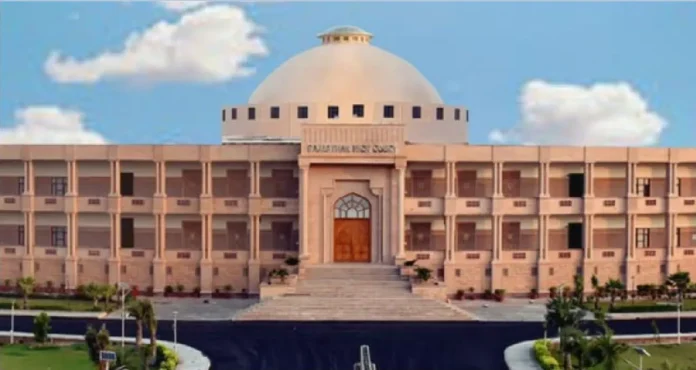The Rajasthan High Court recently intervened to protect 1.19 lakh trees slated for cutting in Shahbad block in the Baran district of the state. The trees were to make way for a pumped storage project, sparking concerns about ecological balance, carbon emissions, and flora and fauna preservation.
The Court’s move followed reports appearing in daily newspapers that highlighted the potential environmental damage that the project could entail. The Division Bench of Justices Pushpendra Singh Bhati and Munnuri Laxman took suo motu cognisance of newspaper reports which said that the project shall consume a huge quantity of forest area and the full-grown trees, which will not only potentially endanger the ecological balance by increasing carbon emissions, but would also be dangerous for the flora and fauna. The area is densely forested and any kind of intensive deforestation would threaten the existence of the flora and fauna of the area.
The bench further noted that this 450-hectares of land soaks about 22.5 lakh metric tons of carbon, and if it is done away with, it shall have a great impact on climate change. The deforestation may also lead to other side effects such as soil erosion, and will act as an impediment in achieving other key environmental benefits. The alternate land provided in Jaisalmer district for afforestation is about 712 kilometres away, and as per the report, they soak only 3,500 metric tons of carbon dioxide which is much lower than the quantity currently being soaked at Baran district.
The High Court further observed that the right to a green and healthy environment is considered as a facet of the right to life enshrined under Article 21 of the Constitution, which in turn, casts responsibility upon the State and its functionaries, not only just to protect the environment from any potential degradation, but also take active steps to preserve, protect and revive the same, thereby ensuring a true meaningful life to its citizenry.
The High Court also referred to a landmark judgment (MK Ranjitsinh & Ors vs Union of India & Ors., Writ Petition (Civil) No.838 of 2019), in which the Supreme Court acknowledged the right to a healthy environment and freedom from climate change’s adverse effects. This decision underscores the critical intersection of climate change and human rights. The apex court had also highlighted India’s existing environmental laws and policies, including the Wildlife (Protection) Act, 1972; Water (Prevention and Control of Pollution) Act,1974; and Air (Prevention and Control of Pollution) Act, 1981. Additionally, the Energy Conservation Act, 2001, was amended in 2022 to empower the central government to provide for a carbon credit trading scheme.
The Court further emphasized that Articles 14 and 21 of the Constitution recognize the right to a clean environment and life. Climate change impacts the right to health, equality, and life, particularly for vulnerable communities.
The judgment stresses that states must prioritize environmental protection and sustainable development. India is compelled to uphold its international obligations, including mitigating greenhouse gas emissions, adapting to climate impacts, and protecting fundamental rights.
In the judgement, the High Court also cited the UN High Commissioner for Human Rights’ emphasis on climate change’s impact on human rights. Further, the Court also referred to the judgment rendered by the apex court, in RE: TN Godavarman Thirumulpad vs Union of India, which stated: “The tiger perishes without the forest and the forest perishes without its tigers. Therefore, the tiger should stand guard over the forest and the forest should protect all its tigers.” This is how the importance of the tigers in the ecosystem has been succinctly described in Mahabharata. The existence of the forest is necessary for the protection of tigers. In turn, if the tiger is protected, the ecosystem which revolves around him is also protected. The tiger represents the apex of the animal pyramid and the protection of their habitat must be a priority.”
The High Court was also conscious of the judgment rendered by the Division Bench of the Sikkim High Court in the case of In Re: Recent Felling of Trees in Gangtok (WP (PIL) No. 04 of 2020, decided on January 10, 2022, which said: “Before dealing with the merits of the matter, it is apposite to cite a poem which poignantly comes to mind, On Killing a Tree, by Gieve Patel.” The theme of the poem is a confrontation between two different attitudes, saving and cutting a tree. It is a tirade against the practice of felling a tree. The poem describes the growth of a tree, the years of consumption of the earth, absorption of sunlight, air, water and nutrients from the soil to grow into a mature tree and the pain on its destruction. The poem makes an implied plea to maintain an ecological balance.
The High Court, while referring to earlier judgments concerning the environment, registered the matter as a suo motu PIL and issued notices to the Union of India, Rajasthan’s Environment and Forest Department, and the Principal Chief Conservator of Forests. The PIL also allowed for an amicus curiae to assist the Court, and directed the respondents to submit a detailed response and requested exploration of alternatives to save the trees.
—By Shivam Sharma and India Legal Bureau


